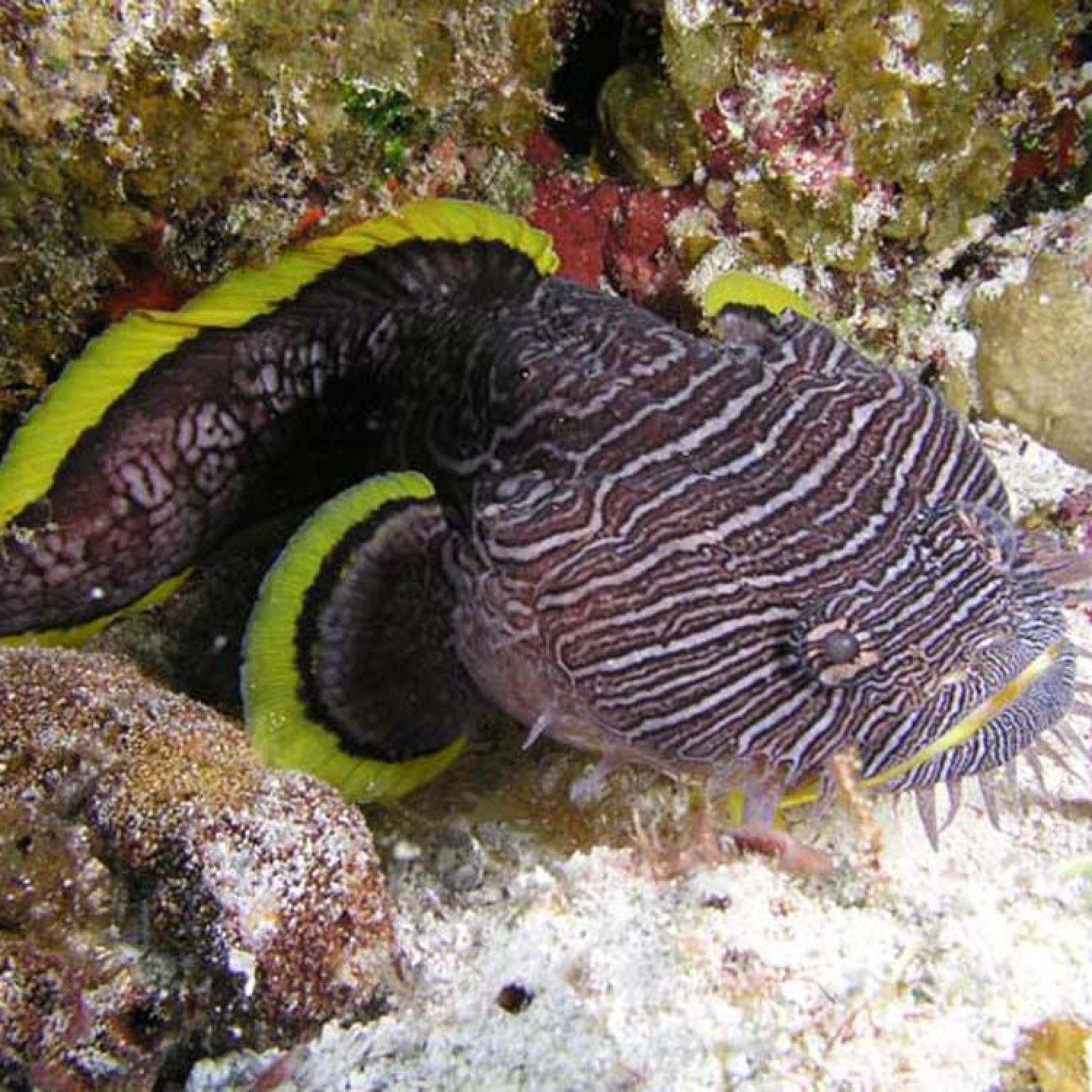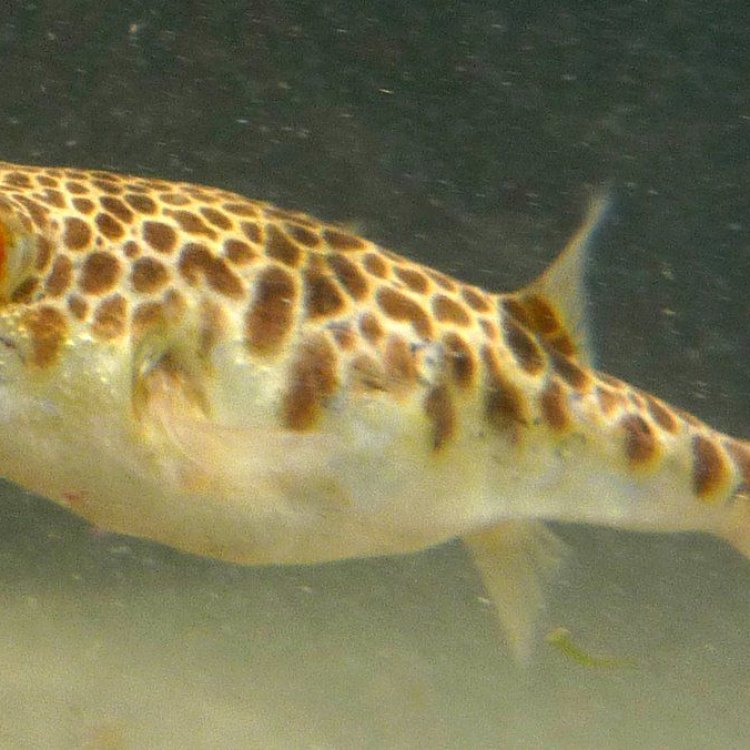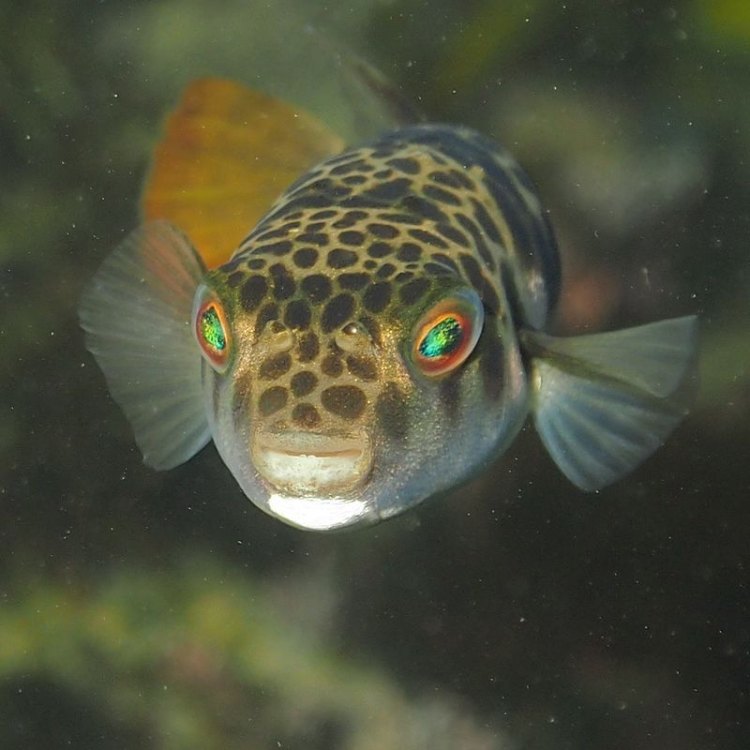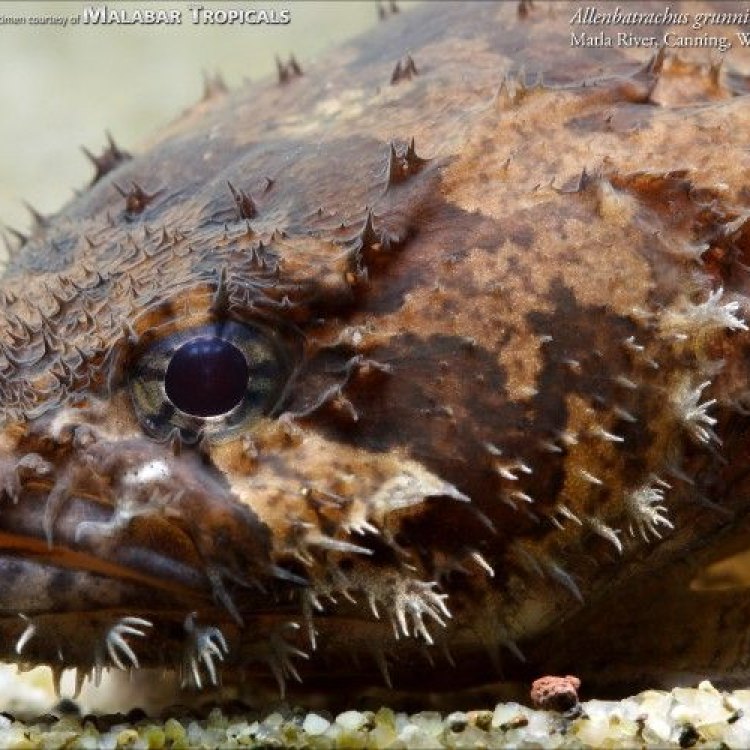
Toadfish
Up to 15 inches
Toadfish, also known as toadbait, can grow up to 15 inches and are commonly found in the North Atlantic Ocean and Gulf of Mexico. With their squat body shape, large head, and wide mouth, they are excellent ambush predators. They are a part of the Batrachoididae family, which includes over 70 different species. Despite their unappealing appearance, they play an important role in maintaining the balance of marine ecosystems. #AnimalFactFriday #Toadfish #MarineLife
Animal Details Summary:
Common Name: Toadfish
Kingdom: Animalia
Habitat: Coastal waters, estuaries, and tidal creeks
Toadfish: The Unlikely Musician of the Ocean
When we think of the ocean, we often imagine the sounds of crashing waves, seagulls calling, and maybe even the occasional whale song. But did you know that there is a fish in the ocean that can make some pretty interesting sounds of its own? Meet the toadfish, the unlikely musician of the ocean.Introducing the Toadfish
Scientifically known as Opsanus beta, the toadfish is a species of fish found in the Western Atlantic Ocean. A member of the Batrachoidiformes order, these fish are commonly known as toadfish due to their resemblance to toads Toadfish. They are part of the Batrachoididae family, which includes over 80 different species of toadfish.Toadfishes can be found in coastal waters, estuaries, and tidal creeks in the United States. Their geographical distribution ranges from the North Atlantic Ocean to the Gulf of Mexico, making them a relatively common sight in these areas.
The Appearance of the Toadfish
At first glance, you may not think much of the toadfish’s appearance. They are typically mottled brown or gray in color, with dark spots covering their bodies. However, upon closer inspection, you will notice that they have a squat, almost toad-like body shape, with a large head and a wide mouth.The toadfish’s unique body shape and coloration allow them to easily camouflage themselves in their environment, making them excellent hunters. But don’t let their unassuming appearance fool you; these fish are true predators.
Feeding Method of the Toadfish
Toadfishes are carnivorous, meaning they primarily eat other animals Teacup Chihuahua. Their diet consists of small crustaceans, fish, and mollusks, which they hunt for at night. During the day, they are known to bury themselves in the sand or hide in crevices to avoid being seen by their prey or potential predators.Their wide-set mouth, equipped with a powerful set of teeth, allows them to easily catch and consume their prey. Toadfishes also have a specialized muscle in their throat, known as the “sonic muscle,” which helps them produce their unique grunting noise.
Understanding the Behavior of Toadfish
One of the most fascinating things about the toadfish is its amazing ability to produce sound. Using its sonic muscle, these fish can emit a loud grunting noise that has been described by some as similar to a foghorn or a belch. These sounds are used for various purposes, including attracting mates, defending territory, and communicating with other fish.Toadfishes are solitary creatures, only coming together during mating season. The male toadfish is known for its elaborate courtship behavior, which involves creating a burrow and calling out to potential females with its loud grunts.
During mating, the female toadfish will lay her eggs in the male’s burrow, and he will guard and care for them until they hatch. This is a significant change from the typical behavior of other fish species, where the female is usually responsible for caring for the eggs.
The Role of Toadfish in the Ecosystem
Toadfishes may not be the most glamorous or well-known creatures in the ocean, but they play a crucial role in their ecosystem. As predators, they help regulate the population of smaller marine animals, preventing a disruption of the food chain. They also serve as prey for larger fish, seabirds, and other animals.Like most marine creatures, toadfishes are also indicators of the health of their habitats. If their population decreases, it could be a sign of changes in the environment that may affect other species as well.
The Threats Facing Toadfish
Unfortunately, toadfishes face various threats to their survival, which puts their role in the ecosystem at risk. Their habitat is quickly disappearing due to human activities, such as coastal development, pollution, and overfishing. These factors can greatly impact their population, making them vulnerable to extinction.Another significant threat to the toadfish is climate change. As the oceans warm and become more acidic, it could adversely affect the reproductive success of these fish, as well as their ability to hunt and defend themselves.
Efforts to Protect Toadfish
As awareness about the importance of marine life continues to grow, efforts are being made to protect and preserve the toadfish and its habitat. Government agencies, conservation groups, and researchers are working together to understand more about these fish and the challenges they face.One such group, the South Carolina Department of Natural Resources, has been studying the toadfish population in the state and raising awareness about their importance in the marine ecosystem. They have also created protected areas to help these fish thrive and have banned commercial fishing of toadfish in certain areas.
Final Thoughts
The toadfish may not be the most eye-catching or well-known creature in the ocean, but it plays an essential role in its ecosystem. From its unique appearance and interesting feeding habits to its ability to produce sound, this fish continues to fascinate and surprise scientists and marine enthusiasts alike.However, with the various threats facing these fish and the larger marine ecosystem, it is crucial that we continue to learn about and protect the toadfish. Only by understanding and preserving these creatures can we ensure a healthy and diverse ocean for generations to come. So the next time you hear an unusual noise while taking a walk on the beach, remember that it may just be a toadfish, the unlikely musician of the ocean.

Toadfish
Animal Details Toadfish - Scientific Name: Opsanus beta
- Category: Animals T
- Scientific Name: Opsanus beta
- Common Name: Toadfish
- Kingdom: Animalia
- Phylum: Chordata
- Class: Actinopterygii
- Order: Batrachoidiformes
- Family: Batrachoididae
- Habitat: Coastal waters, estuaries, and tidal creeks
- Feeding Method: Carnivorous
- Geographical Distribution: Western Atlantic Ocean
- Country of Origin: United States
- Location: North Atlantic Ocean and Gulf of Mexico
- Animal Coloration: Mottled brown or gray with dark spots
- Body Shape: Squat, large head, and a wide mouth
- Length: Up to 15 inches

Toadfish
- Adult Size: 8 to 10 inches
- Average Lifespan: Up to 12 years
- Reproduction: Sexual
- Reproductive Behavior: Nests are made by the male to attract females
- Sound or Call: Male toadfish produce loud grunting or humming sounds during the mating season
- Migration Pattern: Not known for long-distance migration
- Social Groups: Solitary
- Behavior: Nocturnal, bottom-dwelling, and territorial
- Threats: Habitat degradation, pollution, overfishing
- Conservation Status: Not evaluated
- Impact on Ecosystem: Important role in controlling populations of small crustaceans and mollusks
- Human Use: Caught for commercial and recreational fishing, used as bait
- Distinctive Features: Two dorsal fins, venomous spines on the dorsal and anal fins
- Interesting Facts: Toadfish can produce a distress call when caught, causing it to inflate with air and become buoyant
- Predator: Larger predatory fish

Opsanus beta
The Fascinating Life of Toadfish: An Underwater Journey
Deep beneath the ocean's surface, in the murky depths of the Atlantic and Pacific oceans, lives a mysterious and fascinating creature – the toadfish. This small, bottom-dwelling fish may not be as well-known as some of its underwater counterparts, but it is a vital part of the marine ecosystem and has some unique features and behaviors that make it stand out.In this article, we will dive into the world of toadfish and uncover the beauty and complexity of its existence. From its physical characteristics to its reproductive behavior, we will explore the life of a toadfish and the important role it plays in our oceans PeaceOfAnimals.Com.
The Basics
The toadfish, also known as the oyster toadfish or the Atlantic toadfish, is a species of fish found in the coastal waters of the Western Atlantic Ocean, from Nova Scotia to the Gulf of Mexico, and in the Eastern Pacific Ocean, from Baja California to Peru. They have a stout and boxy body with a flattened head and a long, tapering tail. Their coloration can vary, but they typically have a mottled brown or gray pattern that helps them blend in with their surroundings.
Toadfish are known for their unique ability to produce a distress call when caught, which causes them to inflate with air and become buoyant, making it easier for them to escape predators or fishermen's hooks. This ability, along with other interesting facts, makes them one of the most fascinating creatures in the ocean.
Size and Lifespan
Toadfish may not be the biggest fish in the sea, but they certainly make up for it with their interesting behavior and features. As adults, they can reach a size of 8 to 10 inches, with females slightly larger than males. They have a relatively long lifespan for a fish, with some individuals living up to 12 years in the wild.
Reproduction and Behavior
One of the most unique aspects of toadfish is their reproductive behavior Teacup Miniature Horse. They are sexual reproducers, meaning they require a partner to reproduce. During the breeding season, male toadfish will create elaborate nests using shells, vegetation, and debris to attract females. These nests are often referred to as “condos” because they can house multiple females at the same time.
Once a female is lured into the nest, the male will fertilize her eggs, and she will lay them in the nest, where the male will protect them until they hatch. This nesting behavior is not commonly seen in other fish species, making toadfish quite special in the underwater world.
Sound Production
Another unique feature of toadfish is their ability to produce loud grunting or humming sounds, particularly during the mating season. These sounds are produced by vibrating muscles in their swim bladder, which amplifies the sound and makes it travel further in the water. These calls are used to attract females and signal dominance to other males. While they may be loud underwater, these calls are not audible to humans.
Social Behavior
Toadfish are solitary creatures, preferring to spend their time alone on the ocean floor rather than in large groups. While they may come together during the breeding season, they usually keep to themselves and are not known for forming social groups.
Behavior and Habitat
Toadfish are bottom-dwelling fish, meaning they spend most of their time at the bottom of the ocean, hidden among rocks and debris. They are also nocturnal, meaning they are most active at night. During the day, they can often be found hiding in crevices or under rocks, waiting for their prey to come by.
As territorial creatures, toadfish will defend their preferred habitat from other fish and predators. Their sharp teeth and venomous spines on their dorsal and anal fins make them well-equipped to defend themselves.
Threats and Conservation Status
Unfortunately, toadfish face many threats in their natural habitat. Habitat degradation, pollution, and overfishing are all significant concerns for their population. Their nesting behavior makes them particularly vulnerable, as it is easy for their nests to be disturbed or destroyed by human activities.
Despite these threats, toadfish's conservation status has not been evaluated, meaning there is currently no official designation for their conservation status. However, as humans continue to impact their habitats, their population numbers are likely to decline, highlighting the importance of conservation efforts for this unique species.
The Role of Toadfish in the Ecosystem
Although they may not be the most well-known fish, toadfish play a crucial role in the marine ecosystem. As bottom-dwellers, they primarily feed on small crustaceans and mollusks, keeping their populations in check and maintaining a healthy balance in the ocean's food chain. They also serve as prey for larger fish, helping to sustain predator populations.
Human Use
Toadfish are an important commercial and recreational fish species, commonly caught for their meat and used as bait for larger fish. However, their populations are not heavily targeted, and they are not a significant source of income for commercial fisheries. In recreational fishing, they are often seen as a nuisance fish and discarded rather than kept for consumption.
Distinctive Features
One of the most notable physical features of toadfish is their two dorsal fins, one located near the front of their body and the other towards the back. These fins, along with their boxy body shape, help toadfish stay close to the ocean floor and navigate through the rocks and debris of their habitat.
Their venomous spines on their dorsal and anal fins are another unique feature that sets them apart from other fish species. These spines are used as a defense mechanism and can cause significant harm to predators or humans if handled incorrectly.
Interesting Facts
Toadfish have some truly remarkable and interesting facts that make them stand out in the underwater world. Their ability to produce a distress call when caught, causing them to inflate with air and become buoyant, is one of their most incredible features. Another interesting fact about toadfish is their diet – they are known to eat their own eggs if food becomes scarce.
Predators
Despite being well-armed with venomous spines, toadfish still face predators in their natural habitat. Larger predatory fish, such as striped bass and bluefish, are known to prey on toadfish. They also serve as prey for seabirds and other marine creatures.
In Conclusion
From their unique reproductive behavior to their ability to produce loud grunting sounds, toadfish are an intriguing and fascinating species. Although they face threats in their natural habitat, their important role in the ecosystem cannot be overlooked. As humans continue to impact our oceans, it is crucial to recognize and protect the toadfish and other marine species for the health and balance of our planet's underwater world.

Toadfish: The Unlikely Musician of the Ocean
Disclaimer: The content provided is for informational purposes only. We cannot guarantee the accuracy of the information on this page 100%. All information provided here may change without prior notice.












